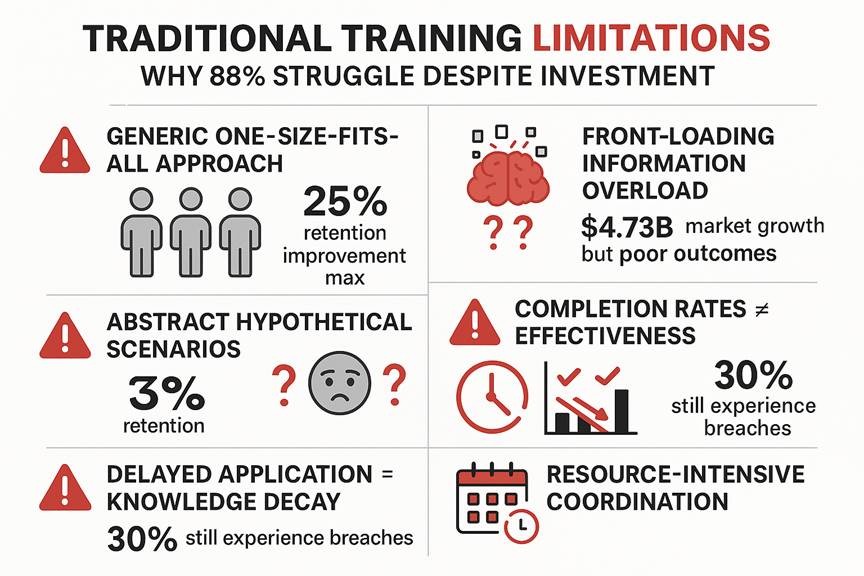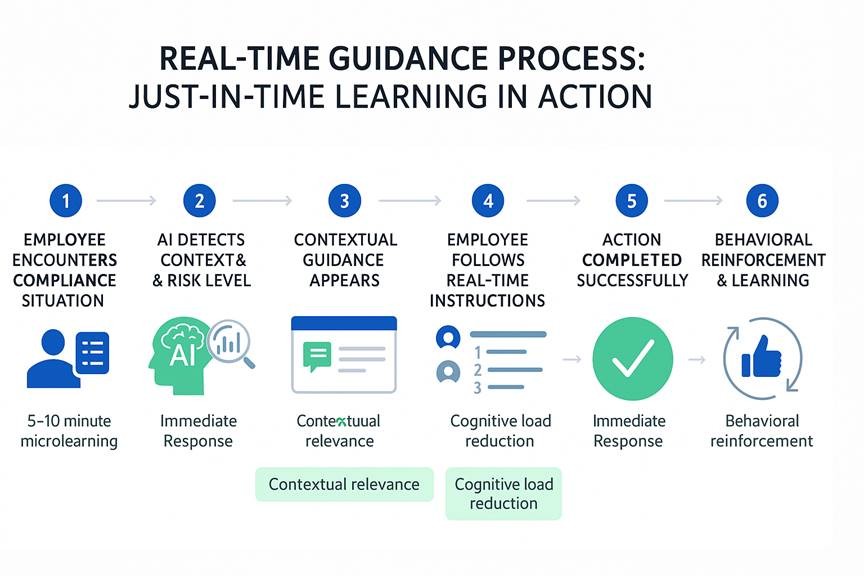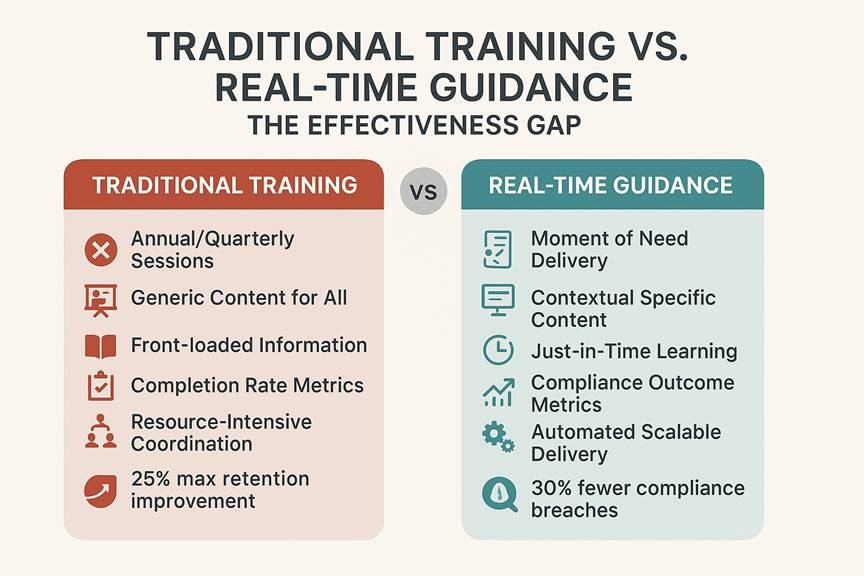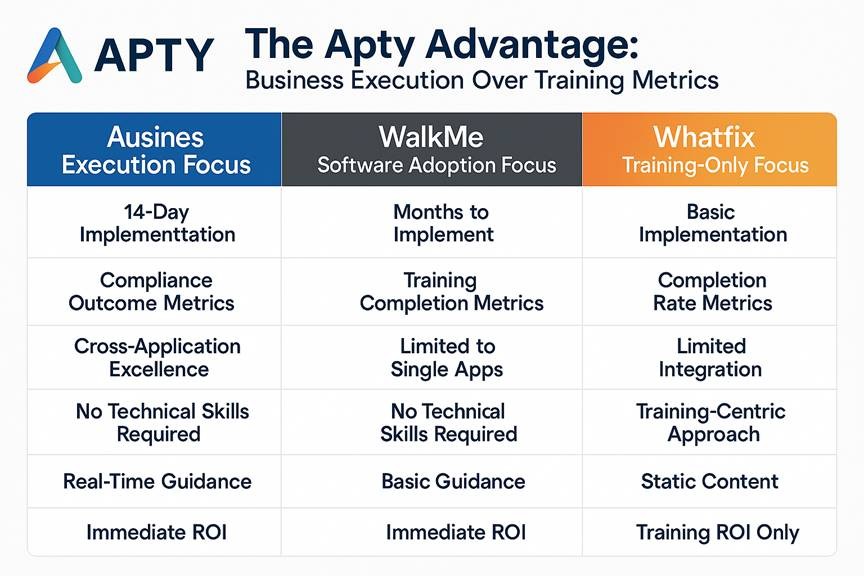Table of Contents
- Executive Summary
- The Compliance Training Paradox: Why Traditional Methods Are Falling Short
- Why Traditional Compliance Training Is No Longer Enough
- Just-in-Time Learning: Delivering Compliance Support When It Matters Most
- Traditional Training vs. Real-Time Guidance: The Effectiveness Gap
- How Modern Compliance Tools Enable Real-Time Support
- Why Apty Leads in Real-Time Compliance Guidance
- FAQs
- Transform Your Compliance Strategy Today
- Key Takeaways:
Executive Summary
Traditional compliance training has been the go-to method for many organizations, but it’s not always effective. Despite investing heavily in training programs, many companies still face compliance issues. The reason? Training sessions are often disconnected from real-life scenarios, making it hard for employees to apply what they’ve learned when needed most.
Real-time guidance is emerging as a better solution. Instead of waiting for an annual training session, real-time guidance delivers helpful information exactly when employees need it. This approach is more relevant, reduces stress, and helps employees make the right decisions on the spot. Studies show that organizations using real-time guidance see fewer compliance breaches—about 30% fewer—compared to those relying solely on traditional training.
Modern compliance tools, like Apty, use cloud and AI technologies to deliver personalized, on-the-job support. Apty’s solution focuses on practical, real-world results by providing guidance in real-time, which improves compliance without overwhelming employees with unnecessary information.
In short, if you want to improve compliance and reduce risks, it’s time to move beyond traditional training and embrace real-time guidance.
The Compliance Training Paradox: Why Traditional Methods Are Falling Short
Did you know 88% of organizations consider compliance training is essential, yet 30% still experience compliance breaches despite extensive training programs?
This startling contradiction reveals a fundamental flaw in how most companies approach regulatory training. While traditional compliance training continues to consume significant resources and employee time, the evidence increasingly points to a more effective alternative: real-time guidance delivered precisely when employees need it most.
The regulatory landscape has evolved dramatically, but training methodologies have largely remained static. Organizations continue to rely on annual training sessions, lengthy modules, and generic content that fails to address the dynamic nature of modern compliance challenges. Meanwhile, a new generation of compliance tools is emerging that delivers just-in-time learning and contextual guidance, fundamentally transforming how employees interact with regulatory requirements.
This shift represents more than a technological upgrade—it’s a complete reimagining of how compliance knowledge is acquired, retained, and applied in real-world scenarios. The question is no longer whether organizations need compliance training, but rather which approach will deliver measurable results in an increasingly complex regulatory environment.

Why Traditional Compliance Training Is No Longer Enough
Traditional regulatory training operates on a fundamentally flawed premise: that employees can absorb comprehensive compliance knowledge during scheduled sessions and reliably apply it weeks or months later when faced with actual compliance decisions. This approach, while well-intentioned, consistently fails to deliver the outcomes organizations desperately need.
The core problem lies in the disconnect between learning and application. Generic one-size-fits-all approaches are becoming obsolete as organizations recognize that compliance challenges vary dramatically across departments, roles, and operational contexts. A sales representative’s compliance concerns differ significantly from those of a data analyst, yet traditional training programs often treat all employees as if they face identical regulatory challenges.
Research from Compliance Week demonstrates that companies adopting tailored training programs report only a 25% increase in retention compared to generic approaches. While this improvement is notable, it still leaves three-quarters of compliance knowledge vulnerable to the natural decay that occurs when information isn’t immediately applied. The human brain simply isn’t designed to retain detailed procedural knowledge indefinitely without reinforcement.
The timing of traditional training creates additional challenges. Front-loading workers with comprehensive compliance information they might not use for months creates cognitive overload and reduces the likelihood of retention when the information is actually needed. Employees often describe compliance training as abstract theorizing about hypothetical scenarios that bear little resemblance to their daily operational realities.
Perhaps most problematically, traditional training metrics focus on completion rates rather than actual effectiveness. Organizations celebrate high completion percentages while remaining blind to whether employees can actually apply compliance principles when faced with real-world decisions. This measurement gap perpetuates ineffective training approaches and provides false confidence in compliance preparedness.
Just-in-Time Learning: Delivering Compliance Support When It Matters Most
Real-time compliance guidance represents a fundamental paradigm shift from traditional training approaches. Rather than attempting to pre-load employees with comprehensive compliance knowledge, just-in-time learning delivers targeted, contextual guidance precisely when employees encounter relevant situations in their workflow.
This methodology transforms compliance from something that happens “once a year in that boring session” into a continuous, supportive presence that guides decision-making in real-time. The effectiveness stems from capitalizing on the moment when employees are most receptive to learning: when they actually need the information to complete their current task.
Contextual relevance eliminates what researchers call the “so what?” factor that plagues traditional training. When compliance guidance appears as an employee navigates a real situation, the relevance is immediately apparent. There’s no abstract theorizing about hypothetical scenarios—the application is obvious and immediate.
Cognitive load reduction represents another significant advantage of just-in-time learning. Rather than overwhelming employees with comprehensive compliance knowledge they may never use, this approach delivers focused, digestible content. Research consistently shows that microlearning modules of 5-10 minutes significantly improve knowledge retention compared to longer training sessions.

Traditional Training vs. Real-Time Guidance: The Effectiveness Gap
The differences between traditional training and real-time guidance extend far beyond delivery mechanisms—they represent fundamentally different philosophies about how compliance knowledge should be acquired and applied.
Traditional training operates on predetermined schedules that rarely align with when employees actually encounter compliance decisions. Annual or quarterly sessions create artificial learning moments disconnected from operational reality. Real-time guidance, conversely, appears precisely when employees need compliance support, ensuring maximum relevance and immediate application.
Traditional approaches attempt to cover comprehensive compliance topics in single sessions, often overwhelming employees with information they may never use. Real-time guidance delivers focused, bite-sized content specific to the immediate situation, reducing cognitive load while increasing retention and application rates.
The evidence increasingly favors real-time approaches. Organizations implementing just-in-time compliance guidance report 30% fewer compliance breaches compared to those relying solely on traditional training methods. This improvement reflects not just better knowledge retention, but more importantly, better application of compliance principles in actual operational contexts.

How Modern Compliance Tools Enable Real-Time Support
The technological infrastructure supporting real-time compliance guidance has matured significantly, making sophisticated compliance support accessible to organizations of all sizes. Modern compliance tools leverage cloud computing, artificial intelligence, and mobile technologies to deliver contextual guidance that integrates seamlessly with existing operational workflows.
Cloud-based learning management systems represent the foundation of effective real-time compliance support. These platforms integrate with existing business software to trigger learning moments automatically, ensuring compliance guidance appears within the applications employees use daily rather than requiring separate training environments.
Artificial intelligence capabilities enable unprecedented personalization of compliance interventions. Machine learning algorithms analyze behavioral patterns, identify risk factors, and predict when employees are most likely to benefit from additional compliance support. This intelligence reduces notification fatigue while increasing the relevance and effectiveness of guidance.
Integration capabilities ensure that compliance tools work within existing technology ecosystems rather than requiring wholesale system replacements. Modern platforms connect with enterprise resource planning systems, customer relationship management platforms, and industry-specific applications to provide compliance support within familiar interfaces.

Why Apty Leads in Real-Time Compliance Guidance
Apty’s approach to Digital Adoption Platform technology represents a fundamental advancement in how organizations can achieve and maintain regulatory compliance. While traditional compliance vendors focus primarily on training completion metrics and documentation requirements, Apty delivers measurable business outcomes that directly address the compliance challenges facing modern organizations.
The business execution focus that distinguishes Apty from competitors becomes particularly valuable in compliance environments where failures can result in severe financial penalties, operational shutdowns, and reputational damage. Rather than measuring success through training completion rates or user engagement scores, Apty focuses on compliance outcomes, error reduction, and regulatory risk mitigation.
Rapid implementation capabilities provide organizations with the ability to achieve compliance improvements within 14 days of deployment, a timeline that contrasts sharply with the months-long implementations typically required by traditional compliance systems. This speed advantage stems from Apty’s implementation methodology that prioritizes high-impact compliance processes and leverages pre-built guidance frameworks for common regulatory requirements.
The competitive landscape reveals significant limitations in alternative approaches. WalkMe’s focus on software adoption metrics rather than business outcomes creates a fundamental misalignment with compliance objectives. Their months-long implementation timelines and requirement for technical expertise create barriers that delay compliance improvements when organizations need immediate risk mitigation.
Whatfix’s training-only approach fails to address the real-time guidance needs that characterize effective compliance support. Their limited integration capabilities and basic functionality restrict organizations to traditional training models that have proven inadequate for modern compliance challenges.

FAQs
Transform Your Compliance Strategy Today
The evidence is clear: traditional compliance training approaches are failing to deliver the outcomes organizations need in increasingly complex regulatory environments. Real-time guidance represents not just an incremental improvement but a fundamental transformation in how compliance knowledge is acquired, retained, and applied.
Organizations that continue to rely solely on traditional training methods will find themselves increasingly vulnerable to compliance failures, regulatory penalties, and operational disruptions. The competitive advantage belongs to those who embrace real-time compliance guidance and leverage technology to deliver contextual support when employees need it most.
Ready to transform your compliance strategy and eliminate regulatory risk? Book a demo with Apty’s compliance experts to discover how real-time guidance can revolutionize your approach to regulatory compliance and deliver measurable improvements in compliance outcomes.
Key Takeaways:
- Traditional Training Isn’t Enough: Traditional training programs don’t match the real-world situations where compliance decisions need to be made. Real-time guidance, provided when employees need it, works better.
- Less Information Overload: Just-in-time learning delivers small, focused bits of information, reducing overwhelm and helping employees remember what’s needed for each task.
- Better Results: Companies using real-time guidance see 30% fewer compliance issues because the help is timely and relevant to the task at hand.
- Modern Tools Make It Easier: Technologies like AI and cloud computing allow for real-time, personalized guidance that fits smoothly into employees’ daily workflows.
Apty Makes Compliance Easier: Apty offers a quicker, more practical solution to improve compliance. Unlike traditional training, Apty focuses on reducing errors and risks, with faster results—implementing in just 14 days.
